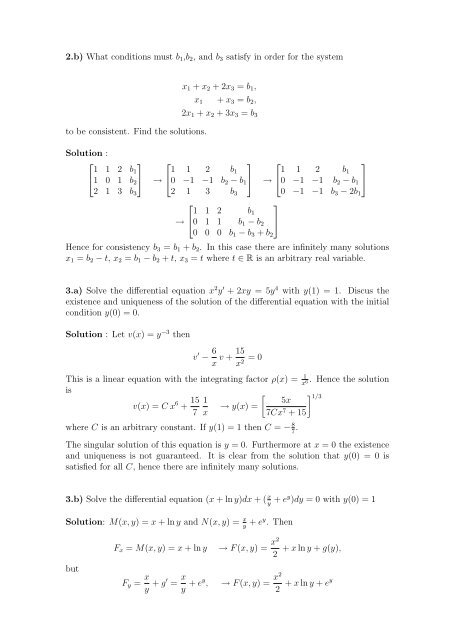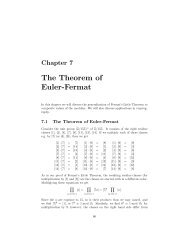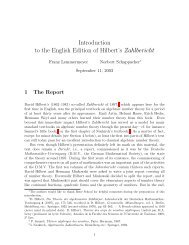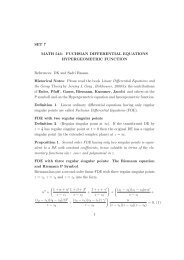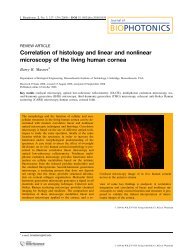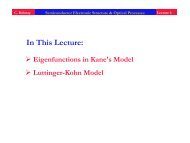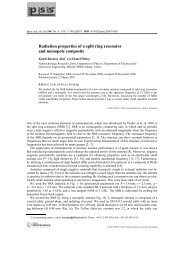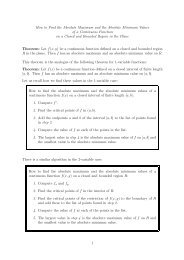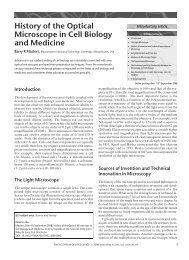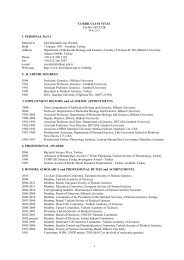MATH 225: DIFFERENTIAL EQUATIONS AND LINEAR ALGEBRA ...
MATH 225: DIFFERENTIAL EQUATIONS AND LINEAR ALGEBRA ...
MATH 225: DIFFERENTIAL EQUATIONS AND LINEAR ALGEBRA ...
You also want an ePaper? Increase the reach of your titles
YUMPU automatically turns print PDFs into web optimized ePapers that Google loves.
2.b) What conditions must b1,b2, and b3 satisfy in order for the system<br />
x1 + x2 + 2x3 = b1,<br />
x1<br />
to be consistent. Find the solutions.<br />
+ x3 = b2,<br />
2x1 + x2 + 3x3 = b3<br />
Solution :<br />
⎡<br />
1<br />
⎣1<br />
1<br />
0<br />
2<br />
1<br />
⎤<br />
b1<br />
b2⎦<br />
⎡<br />
1<br />
→ ⎣0<br />
1<br />
−1<br />
2<br />
−1<br />
⎤<br />
b1<br />
b2 − b1⎦<br />
⎡<br />
1<br />
→ ⎣0<br />
1<br />
−1<br />
2<br />
−1<br />
⎤<br />
b1<br />
b2 − b1 ⎦<br />
2 1 3 b3 2 1 3 b3 0 −1 −1 b3 − 2b1<br />
⎡<br />
1<br />
→ ⎣0<br />
1<br />
1<br />
2<br />
1<br />
b1<br />
b1 − b2<br />
⎤<br />
⎦<br />
0 0 0 b1 − b3 + b2<br />
Hence for consistency b3 = b1 + b2. In this case there are infinitely many solutions<br />
x1 = b2 − t, x2 = b1 − b2 + t, x3 = t where t ∈ R is an arbitrary real variable.<br />
3.a) Solve the differential equation x 2 y ′ + 2xy = 5y 4 with y(1) = 1. Discus the<br />
existence and uniqueness of the solution of the differential equation with the initial<br />
condition y(0) = 0.<br />
Solution : Let v(x) = y −3 then<br />
v ′ − 6<br />
x<br />
15<br />
v + = 0<br />
x2 This is a linear equation with the integrating factor ρ(x) = 1<br />
x 6 . Hence the solution<br />
is<br />
v(x) = C x 6 + 15<br />
7<br />
1<br />
x<br />
�<br />
5x<br />
→ y(x) =<br />
7Cx7 + 15<br />
where C is an arbitrary constant. If y(1) = 1 then C = − 8<br />
7 .<br />
The singular solution of this equation is y = 0. Furthermore at x = 0 the existence<br />
and uniqueness is not guaranteed. It is clear from the solution that y(0) = 0 is<br />
satisfied for all C, hence there are infinitely many solutions.<br />
3.b) Solve the differential equation (x + ln y)dx + ( x<br />
y + ey )dy = 0 with y(0) = 1<br />
Solution: M(x, y) = x + ln y and N(x, y) = x<br />
y + ey . Then<br />
but<br />
Fx = M(x, y) = x + ln y → F (x, y) = x2<br />
2<br />
� 1/3<br />
+ x ln y + g(y),<br />
Fy = x<br />
y + g′ = x<br />
y + ey , → F (x, y) = x2<br />
+ x ln y + ey<br />
2


